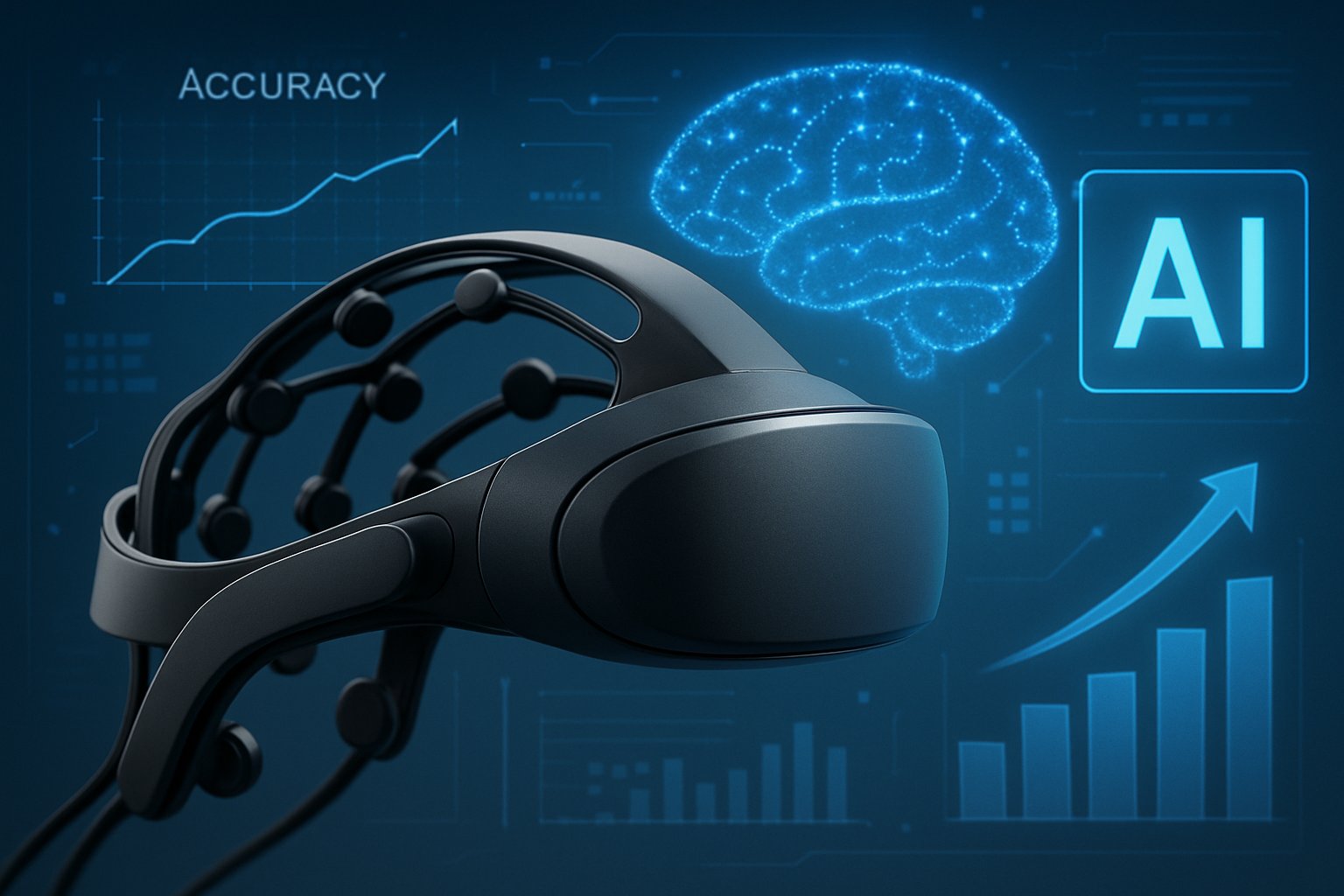
AI CERTS
20 hours ago
UCLA’s AI Co-Pilot Elevates Non-Invasive BCI Performance
Therefore, risk-averse clinics could trial the approach sooner. This article unpacks the architecture, results, business context, and ethical stakes behind UCLA’s breakthrough.
Core Study Key Highlights
UCLA researchers evaluated the platform with four participants, including one living with cervical paralysis. Participants wore a wearable neural interface consisting of a 64-channel EEG headcap. During trials, the non-invasive BCI processed continuous neural activity and sent commands to a computer cursor or robotic arm. Consequently, users attempted 8-target center-out movements and complex pick-and-place actions. Without AI help, results remained modest. With the vision-based AI co-pilot activated, accuracy soared 3.9× for the paralyzed participant. Moreover, task completion time dropped to roughly 6.5 minutes from impossible.

The primary clinical goal remains paralyzed patient assistance that avoids surgical implants. These findings showcase tangible functional gains for users. However, reproducibility across larger cohorts remains to be proven. Therefore, understanding the underlying architecture becomes crucial.
Technical Architecture Breakdown Details
At the heart lies a hybrid CNN-Kalman decoder that handles EEG signal decoding in real time. Initially, the convolutional layers extract spectral-spatial features from noisy scalp measurements. Subsequently, the adaptive Kalman filter refines trajectories, compensating for drift and nonstationarity. Meanwhile, a separate vision-based AI model surveys the environment through an RGB camera. It predicts likely goals, such as the intended cursor target or grasp point on an object. Consequently, both streams merge inside a shared autonomy controller that gently biases output toward the predicted goal.
This fusion allows the non-invasive BCI to overcome low spatial resolution inherent to scalp recordings. Furthermore, online adaptation updates weights every few seconds, sustaining stability during long sessions. Crucially, online EEG signal decoding adapts within seconds, keeping latency below 120 milliseconds. Developers trained the non-invasive BCI with only 10 minutes of calibration data.
In sum, the architecture marries data-driven and probabilistic methods for robustness. Moreover, environment awareness supplies context the neural stream alone cannot provide. Consequently, performance numbers deserve close inspection.
Performance Metrics Analyzed Thoroughly
Researchers reported metrics for both able-bodied and paralyzed participants across 60 cursor trials each. With AI assistance, hit rate averaged 87 %, compared with 22 % using neural control alone. The paralyzed participant achieved the widely cited 3.9× improvement. Time-to-target also shrank by 42 % on average. In the robotic scenario, only the AI-augmented session finished, clocking 6.5 minutes.
- 3.9× cursor accuracy gain
- 42 % faster target acquisition
- 6.5 minute robot task completion
- 4-participant preliminary cohort
The data confirm that a well-designed non-invasive BCI can rival early implant systems in structured tasks. Stable EEG signal decoding mattered more than sampling rate increases. The vision-based AI also filtered false positives during idle intervals. Nevertheless, investigators cautioned that results stem from a small sample and controlled tasks. Therefore, larger multi-site studies will be necessary to confirm generalization.
Early numbers still illustrate the promise of shared autonomy. Meanwhile, investors monitor market signals created by such gains.
Market Context Overview Today
Grand View Research pegs the global BCI market near USD 2.5 billion in 2024. Moreover, analysts forecast a 17 % compound annual growth rate, reaching roughly USD 6.5 billion by 2030. In contrast, invasive implant vendors dominate current high-performance use cases. However, a scalable non-invasive BCI could tap consumer, clinical, and industrial segments that avoid surgery. Consequently, UCLA’s open science approach may accelerate spin-offs and collaborations.
Professionals can enhance their expertise with the AI in Healthcare™ certification. Furthermore, such credentials give product teams credibility when courting regulators and investors. Startups now pitch vision-based AI copilots as differentiators in crowded headset catalogs.
Market forecasts suggest ample room for safer neurotech options. Consequently, ethics and regulation will shape adoption curves.
Ethical And Regulatory Landscape
Lawmakers increasingly view neural data as sensitive health information. In April 2025, U.S. senators urged the FTC to probe neurotech privacy practices. Meanwhile, UNESCO adopted global neurotechnology standards in November 2025, emphasizing mental privacy. Consequently, developers of any non-invasive BCI must implement rigorous consent, deletion, and data-minimization policies. Shared autonomy complicates agency because AI may override ambiguous brain signals. Nevertheless, UCLA investigators allowed users to veto co-pilot suggestions, preserving control. Future guidelines will likely demand transparent fallback modes and explainable intent models.
Strong governance can build user trust and speed approvals. Therefore, technical roadmaps must integrate sociotechnical research.
Future Research Roadmap Ahead
Kao’s team plans larger cohorts and multi-week home studies to test durability. Additionally, engineers aim to expand vision-based AI to manipulate fragile objects with adaptive grip. Researchers also intend to upgrade EEG signal decoding using self-supervised pretraining on public datasets. Furthermore, integrating eye tracking could supply complementary intent cues.
For paralyzed patient assistance at scale, engineers must optimize donning time and comfort of the wearable neural interface. Moreover, cloud inference may reduce headset weight but raises additional security questions.
- How stable are weekly calibrations?
- Will users accept AI overrides?
- Can privacy safeguards satisfy regulators?
Subsequently, successful answers could propel non-invasive BCI devices into everyday rehabilitation clinics and smart homes. Mass production of the wearable neural interface could lower costs dramatically. Achieving home use will require a waterproof non-invasive BCI cap. Long-term paralyzed patient assistance will depend on insurer reimbursement models.
Research momentum remains strong, yet clinical validation is pending. Nevertheless, recent advances hint at a transformative decade.
Conclusion And Next Steps
UCLA’s study illustrates how shared autonomy can turn noisy scalp signals into practical action. Consequently, the non-invasive BCI with vision-based AI quadrupled accuracy and enabled real-world manipulation. Furthermore, open data and modular code empower researchers to replicate EEG signal decoding pipelines and iterate rapidly. Nevertheless, paralyzed patient assistance at scale still hinges on larger trials, privacy safeguards, and affordable wearable neural interface hardware. Therefore, professionals should track upcoming results. Additionally, they can strengthen credentials through the AI in Healthcare™ certification to stay competitive.



